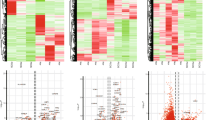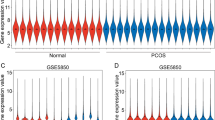Abstract
To identify genes involving in the pathogenesis of polycystic ovary syndrome (PCOS). In this study, the comprehensive analysis of GSE8157 was downloaded. Overlapping genes of differentially expressed genes (DEGs) were identified, and enrichment analysis for these genes was performed. A modular network of differentially expressed genes was constructed by weighted gene co-expression network analyses (WGCNA), and a total of 322 differentially expressed genes in 5 stable modules were screened. The correlations of genes of the stable modules in BioGRID 3.4, STRING 10.5, HPRD9 databases were screened, and the interaction network of 104 DEGs was constructed. In addition, some genes and the key words were searched in CTD. A total of 596 differentially expressed genes were screened, including 379 genes that were up-regulated in case group and down-regulated in control group and treat group, and 217 genes that were down-regulated in case group and up-regulated in control group and treat group. The differentially expressed genes were enriched in PPAR signaling pathway, Neuroactive ligand-receptor interaction, cAMP signaling pathway, of which pathways were involved in the cancer development. Finally, 7 important target genes were identified, such as APOC3 was interacted with pioglitazone, ADCY2 involved in cAMP signaling pathway, and the genes (C3AR1, HRH2, GRIA1, MLNR and TAAR2) involved in neuroactive ligand-receptor interaction. In addition, the important target genes were significantly differential expression. These results implied that the 7 important target genes were played an important role in the development and progression of PCOS. Our study implied that genes had played a key role in the development and progression of PCOS, the results showed that microarray can be use as a method for the discovery of new biomarkers and therapeutic targets for PCOS.




Similar content being viewed by others
References
Shahebrahimi K, Jalilian N, Bazgir N, Rezaei M (2016) Comparison clinical and metabolic effects of metformin and pioglitazone in polycystic ovary syndrome. Indian J Endocrinol Metab 20(6):805–809
Guido M, Romualdi D, Suriano R, Giuliani M, Costantini B, Apa R, Lanzone A (2004) Effect of pioglitazone treatment on the adrenal androgen response to corticotrophin in obese patients with polycystic ovary syndrome. Hum Reprod 19(3):534–539
Schröder AK, Tauchert S, Ortmann O, Diedrich K, Weiss JM (2004) Insulin resistance in patients with polycystic ovary syndrome. Ann Med 36(6):426–439
De LV, La MA, Petraglia F (2003) Insulin-lowering agents in the management of polycystic ovary syndrome. Endocr Rev 24(5):633–667
Skov V, Glintborg D, Knudsen S, Tan Q, Jensen T, Kruse TA, Beck-Nielsen H, Højlund K (2008) Pioglitazone enhances mitochondrial biogenesis and ribosomal protein biosynthesis in skeletal muscle in polycystic ovary syndrome. PLoS One 3(6):e2466
Tang T, Norman RJ, Balen AH, Lord JM (2003) Insulin-sensitising drugs (metformin, troglitazone, rosiglitazone, pioglitazone, D-chiro-inositol) for polycystic ovary syndrome. Cochrane Database Syst Rev 3(3):CD003053
Glueck CJ, Moreira A, Goldenberg N, Sieve L, Wang P (2003) Pioglitazone and metformin in obese women with polycystic ovary syndrome not optimally responsive to metformin. Hum Reprod 18(8):1618–1625
Barrett T, Troup DB, Wilhite SE, Ledoux P, Evangelista C, Kim IF, Tomashevsky M, Marshall KA, Phillippy KH, Sherman PM (2011) NCBI GEO: archive for functional genomics data sets—10 years on. Nucleic Acids Res 39(Database issue):D1005
Li Y, Ngom A, Rueda L (2010) Missing value imputation methods for gene-sample-time microarray data analysis. IEEE Symposium on Computational Intelligence in Bioinformatics & Computational Biology:1–7
Smyth GK (2011) Limma: linear models for microarray data. In: Bioinformatics & Computational Biology Solutions Using R & Bioconductor, pp 397–420. https://doi.org/10.1007/0-387-29362-0_23
Sherlock G (2000) Gene ontology: tool for the unification of biology. The Gene Ontology Consortium. Nat Genet 25(1):25–29
Kanehisa M, Furumichi M, Tanabe M, Sato Y, Morishima K (2017) KEGG: new perspectives on genomes, pathways, diseases and drugs. Nucleic Acids Res 45(Database issue):D353–D361
Dennis G, Sherman BT, Hosack DA, Yang J, Gao W, Lane HC, Lempicki RA (2003) DAVID: database for annotation, visualization, and integrated discovery. Genome Biol 4(5):P3
Langfelder P, Horvath S (2008) WGCNA: an R package for weighted correlation network analysis. Bmc Bioinformatics 9(1):559
Medina IR, Lubovacpilav Z (2016) Gene co-expression network analysis for identifying modules and functionally enriched pathways in type 1 diabetes. PLoS One 11(6):e0156006
BJ B, C S TR, L B AB, M L RO, DH L, J B VW (2008) The BioGRID interaction database: 2008 update. Nucleic Acids Res 36(Database issue):637–640
Szklarczyk D, Morris JH, Cook H, Kuhn M, Wyder S, Simonovic M, Santos A, Doncheva NT, Roth A, Bork P (2017) The STRING database in 2017: quality-controlled protein–protein association networks, made broadly accessible. Nucleic Acids Res 45(Database issue):D362–D368
Mohmood R, Ramachandra YI, Krishna V, Rahiman BA, Mohan S, Ranganathan P, Ramabadran S, Kashyap MK (2009) Human protein reference database - 2009 update
Davis AP, Wiegers TC, Wiegers J, Johnson RJ, Sciaky D, Grondin CJ, Mattingly CJ (2018) Chemical-induced phenotypes at CTD help inform the pre-disease state and construct adverse outcome pathways. Toxicological Sciences An Official Journal of the Society of Toxicology
Jong MC, Hofker MH, Havekes LM (1999) Role of ApoCs in lipoprotein metabolism: functional differences between ApoC1, ApoC2, and ApoC3. Arterioscler Thromb Vasc Biol 19(3):472
Jong MC, Hofker MH, Havekes LM (1999) Role of ApoCs in lipoprotein metabolism. Arterioscler Thromb Vasc Biol 19(3):472–484
Jackson CL, Breslow JL (1984) Isolation and sequence of a human apolipoprotein CII cDNA clone and its use to isolate and map to human chromosome 19 the gene for apolipoprotein CII. Proc Natl Acad Sci U S A 81(10):2945–2949
Shachter NS, Hayek T, Leff T, Smith JD, Rosenberg DW, Walsh A, Ramakrishnan R, Goldberg IJ, Ginsberg HN, Breslow JL (1994) Overexpression of apolipoprotein CII causes hypertriglyceridemia in transgenic mice. J Clin Investig 93(4):1683–1690
Braun-Falco O, Plewig G, Wolff HH, Burgdorf WHC (2000) Disorders of lipoprotein and lipid metabolism
Silva HVD, Lauer SJ, Wang J, Simonet WS, Weisgraber KH, Mahley RW, Taylor JM (1994) Overexpression of human apolipoprotein C-III in transgenic mice results in an accumulation of apolipoprotein B48 remnants that is corrected by excess apolipoprotein E. J Biol Chem 269(3):2324
Shulman RS, Herbert PN, Wehrly K, Fredrickson DS (1975) Thf complete amino acid sequence of C-I (apoLp-Ser), an apolipoprotein from human very low density lipoproteins. J Biol Chem 250(1):182–190
Jong MC, Gijbels MJ, Dahlmans VE, Gorp PJ, Koopman SJ, Ponec M, ., Hofker MH, Havekes LM (1998) Hyperlipidemia and cutaneous abnormalities in transgenic mice overexpressing human apolipoprotein C1. J Clin Investig 101 (1):145
Jong MC, Dahlmans VE, Gorp PJ, Van DKW, Van BML, Hofker MH, Havekes LM (1996) In the absence of the low density lipoprotein receptor, human apolipoprotein C1 overexpression in transgenic mice inhibits the hepatic uptake of very low density lipoproteins via a receptor-associated protein-sensitive pathway. J Clin Investig 98(10):2259–2267
Shachter NS, Ebara TR, Steiner G, Breslow JL, Ginsberg HN, Smith JD (1996) Combined hyperlipidemia in transgenic mice overexpressing human apolipoprotein Cl. J Clin Investig 98(3):846
Samanci C, Alis D, Ustabasioglu FE, Ozmen E, Ucar AK, Aslan M, Habibi HA, Bakan S, Ozcabi B, Evliyaoğlu SO (2016) Apparent diffusion coefficient measurement of ovarian stroma: a potential tool for the diagnosis of polycystic ovary syndrome. Diagn Interv Imaging 98(1):57–61
Author information
Authors and Affiliations
Corresponding author
Ethics declarations
Competing Interests
The authors declare that they have no competing interests.
Additional information
Publisher’s Note
Springer Nature remains neutral with regard to jurisdictional claims in published maps and institutional affiliations.
Electronic supplementary material
ESM 1
(XLSX 56 kb)
Rights and permissions
About this article
Cite this article
He, D., Liu, L., Wang, Y. et al. A Novel Genes Signature Associated with the Progression of Polycystic Ovary Syndrome. Pathol. Oncol. Res. 26, 575–582 (2020). https://doi.org/10.1007/s12253-019-00676-3
Received:
Accepted:
Published:
Issue Date:
DOI: https://doi.org/10.1007/s12253-019-00676-3




